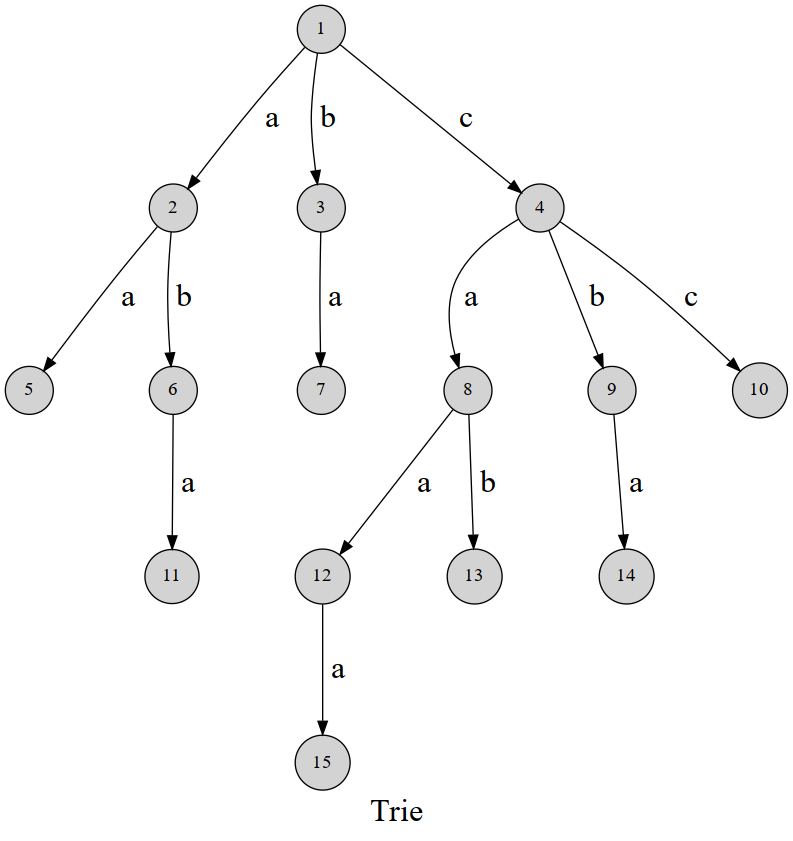Trie
Trie, also called prefix tree or digital tree, is a tree like a dictionary.
Introduction¶
Let's look at a figure first:

It can be found that this trie uses edges to represent letters, and the path from the root node to a node on the tree represents a string. For example, caa.
The structure of trie is very easy to understand. We use
Sometimes it is necessary to mark which strings are inserted into trie, and each time the insertion is completed, mark the node represented by this string.
Code implementation¶
Here we have a template for structure encapsulation:
struct trie {
int nex[100000][26], cnt;
bool exist[100000]; // check whether the string at the end of the node exists
void insert(char *s, int l) { // insert the string
int p = 0;
for (int i = 0; i < l; i++) {
int c = s[i] - 'a';
if (!nex[p][c]) nex[p][c] = ++cnt; // if does not exist, then add node
p = nex[p][c];
}
exist[p] = 1;
}
bool find(char *s, int l) { // find the string
int p = 0;
for (int i = 0; i < l; i++) {
int c = s[i] - 'a';
if (!nex[p][c]) return 0;
p = nex[p][c];
}
return exist[p];
}
};Application¶
Search strings¶
The most basic application of the trie is to find whether a string appeared in the "dictionary".
So he started the wrong roll call (original link in Chinese)
There are
Solution
Create trie for all names, and then query whether the string exists in trie and whether it has already been called. Each name is marked as called after the first call.
Template code
#include <cstdio>
const int N = 500010;
char s[60];
int n, m, ch[N][26], tag[N], tot = 1;
int main() {
scanf("%d", &n);
for (int i = 1; i <= n; ++i) {
scanf("%s", s + 1);
int u = 1;
for (int j = 1; s[j]; ++j) {
int c = s[j] - 'a';
if (!ch[u][c]) ch[u][c] = ++tot;
u = ch[u][c];
}
tag[u] = 1;
}
scanf("%d", &m);
while (m--) {
scanf("%s", s + 1);
int u = 1;
for (int j = 1; s[j]; ++j) {
int c = s[j] - 'a';
u = ch[u][c];
if (!u) break; // the absence of the corresponding character indicates that the name does not exist
}
if (tag[u] == 1) {
tag[u] = 2;
puts("OK");
} else if (tag[u] == 2)
puts("REPEAT");
else
puts("WRONG");
}
return 0;
}AC automation¶
Trie is part of AC automation.
XOR related¶
We regard the binary representation of a number as a string, so a trie whose character set is
BZOJ1954 longest XOR path (original link in Chinese)
Given a tree with edge weights, find
The number of nodes does not exceed
Solution
Randomly specify a root
So, if you insert all
Starting from the root of the trie, if you can go to a subtree different from the present bit of
Correctness of Greedy solution: If you go this way, the present bit will be
Template code
#include <algorithm>
#include <cstdio>
const int N = 100010;
int head[N], nxt[N << 1], to[N << 1], weight[N << 1], cnt;
int n, dis[N], ch[N << 5][2], tot = 1, ans;
void insert(int x) {
for (int i = 30, u = 1; i >= 0; --i) {
int c = ((x >> i) & 1);
if (!ch[u][c]) ch[u][c] = ++tot;
u = ch[u][c];
}
}
void get(int x) {
int res = 0;
for (int i = 30, u = 1; i >= 0; --i) {
int c = ((x >> i) & 1);
if (ch[u][c ^ 1]) {
u = ch[u][c ^ 1];
res |= (1 << i);
} else
u = ch[u][c];
}
ans = std::max(ans, res);
}
void add(int u, int v, int w) {
nxt[++cnt] = head[u];
head[u] = cnt;
to[cnt] = v;
weight[cnt] = w;
}
void dfs(int u, int fa) {
insert(dis[u]);
get(dis[u]);
for (int i = head[u]; i; i = nxt[i]) {
int v = to[i];
if (v == fa) continue;
dis[v] = dis[u] ^ weight[i];
dfs(v, u);
}
}
int main() {
scanf("%d", &n);
for (int i = 1; i < n; ++i) {
int u, v, w;
scanf("%d%d%d", &u, &v, &w);
add(u, v, w);
add(v, u, w);
}
dfs(1, 0);
printf("%d", ans);
return 0;
}Persistent trie¶
For more details, please see persistent trie.
buildLast update and/or translate time of this article,Check the history
editFound smelly bugs? Translation outdated? Wanna contribute with us? Edit this Page on Github
peopleContributor of this article OI-wiki
translateTranslator of this article Visit the original article!
copyrightThe article is available under CC BY-SA 4.0 & SATA ; additional terms may apply.